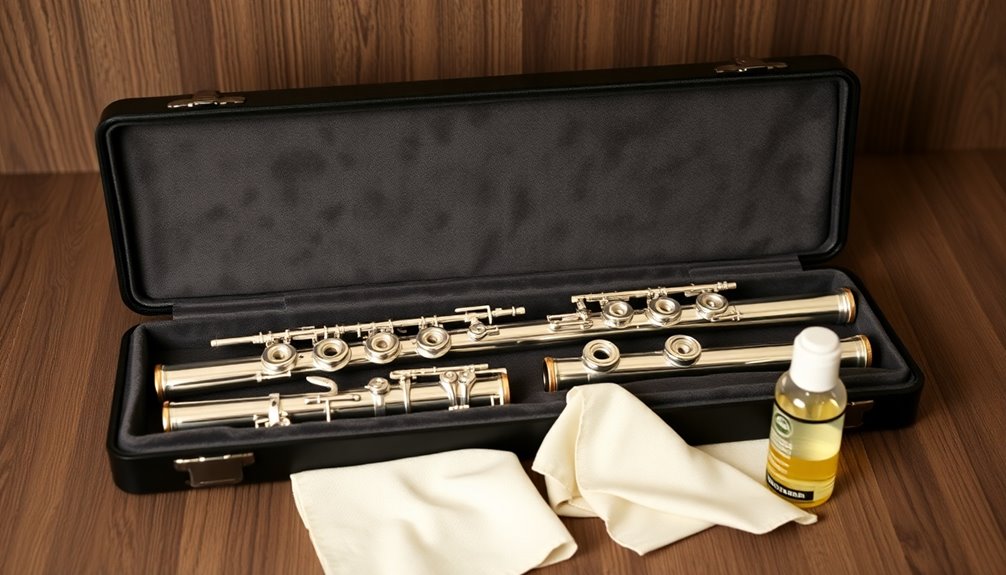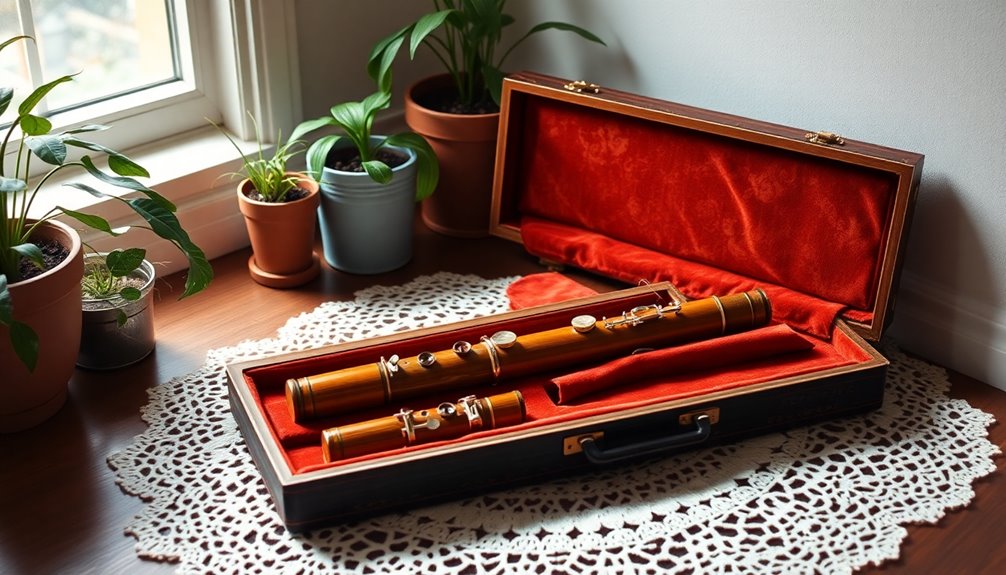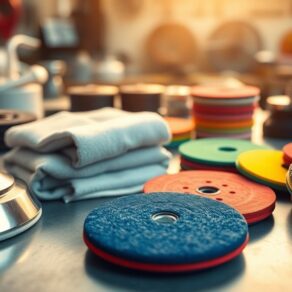To store your flute for long-term care, start by cleaning it thoroughly to remove moisture and fingerprints. Use a sturdy, padded case that fits snugly to protect against dust and accidental damage. Maintain humidity levels between 40% and 60% to avoid damage, and keep your flute in a stable temperature range of 50°F to 70°F. Choose a safe location away from pets and direct sunlight to minimize risk. Regularly inspect your flute for dents or worn pads to guarantee it stays in prime condition. Discover more tips to enhance your flute's longevity and performance.
Key Takeaways
- Maintain ideal humidity levels between 40% – 60% to prevent damage to your flute.
- Store your flute in a sturdy, padded case to protect against accidental bumps and impacts.
- Keep your flute in a stable environment, avoiding extreme temperatures and direct sunlight.
- Regularly inspect the flute for dents, scratches, and pad wear to ensure it remains in optimal condition.
- Use protective accessories like covers to shield the flute from dust and moisture when not in use.
Clean Your Flute Thoroughly

Cleaning your flute thoroughly is crucial for maintaining its sound quality and longevity. Regular maintenance not only keeps your instrument looking great, but it also guarantees it performs at its best.
Start by gathering your flute cleaning tools: a soft, lint-free cloth, a cleaning rod, and a microfiber swab. These items are essential for effective cleaning.
After playing, gently wipe down the exterior of your flute with the cloth to remove fingerprints and moisture. Next, use the cleaning rod with a microfiber swab to clean the inside of the flute. Insert it carefully, making sure you don't scratch the pads or any surfaces.
For those hard-to-reach areas, a soft brush can be beneficial to dislodge any debris. Remember, avoid using harsh chemicals or abrasive materials, as they can damage your flute. Additionally, utilizing a comprehensive flute cleaning kit can enhance your cleaning routine and provide the necessary tools for thorough maintenance.
Finally, finish off your cleaning routine by checking the pads for any signs of wear or moisture.
Following these flute cleaning tips not only enhances your instrument's performance but also fosters a sense of belonging to the community of flute players who understand the importance of proper care. Keep your flute in top shape, and it'll reward you with beautiful music for years to come.
Use a Proper Case

Using a proper case is essential for protecting your flute from damage and ensuring it stays in top condition. A good case not only keeps your instrument safe from physical harm but also helps maintain its overall integrity. When selecting a case, pay attention to the case materials and features that best suit your needs.
| Case Material | Features | Benefits |
|---|---|---|
| Hard Shell | Impact-resistant design | Maximum protection |
| Soft Case | Lightweight and portable | Easy to carry |
| Wooden Case | Elegant appearance | Aesthetic appeal and durability |
| Padded Case | Extra cushioning | Added protection against bumps |
A hard shell case is great for serious players who travel frequently, while a soft case can be perfect for casual use. Consider additional features, like built-in compartments for accessories, to keep everything organized. When you choose the right case, you're not just protecting your flute; you're also investing in your musical journey. Remember, a well-protected flute means more moments to create beautiful music together! Additionally, selecting a case made from durable materials ensures long-lasting protection against wear and tear.
Maintain Ideal Humidity

Maintaining ideal humidity is essential for your flute's longevity and performance, as fluctuations can lead to issues like warping or pad deterioration. To guarantee your instrument stays in top shape, you need to implement effective humidity control strategies.
First, aim for a humidity level between 40% and 60%. This range helps prevent damage while keeping your pads and corks in good condition. You can use a hygrometer to monitor moisture levels in your storage area. If the humidity dips too low, consider using a humidifier or moisture-absorbing packets specifically designed for musical instruments.
Additionally, if you live in an area with extreme humidity changes, invest in a case with built-in humidity control. Some cases offer compartments for moisture monitoring tools, guaranteeing your flute's environment remains stable. Regularly checking the humidity can save you from costly repairs down the line. Furthermore, regular cleaning using a flute cleaning kit can help maintain your instrument's condition and performance. By taking these steps, you're not just protecting your flute; you're also preserving the joy of music-making.
Avoid Extreme Temperatures

When it comes to your flute, avoiding extreme temperatures is crucial for its overall health and performance. Temperature fluctuations can lead to issues like heat damage, which can warp your instrument and affect its sound quality. To keep your flute in top shape, consider the following tips:
| Temperature Range | Potential Risks |
|---|---|
| Below 32°F (0°C) | Condensation and freezing |
| 32°F – 50°F (0°C – 10°C) | Increased humidity exposure |
| 50°F – 70°F (10°C – 21°C) | Ideal storage temperature |
| 70°F – 90°F (21°C – 32°C) | Potential heat damage |
| Above 90°F (32°C) | Extreme heat damage |
Store your flute in a stable environment, avoiding places like cars or direct sunlight. Rapid changes in temperature can also create moisture issues, leading to mold or rust. If you're traveling, use a padded case that insulates against temperature extremes. Additionally, maintaining a routine cleaning schedule will help protect your flute from damage caused by moisture. By being mindful of the climate your flute is exposed to, you're ensuring its longevity and your playing enjoyment. Remember, your instrument deserves the best care, just like you do!
Store in a Safe Location

After safeguarding your flute from extreme temperatures, the next step is to guarantee it's stored in a safe location. This means choosing a place where your instrument can thrive without the risk of damage.
Start by identifying safe environments—areas free from humidity, direct sunlight, and heavy foot traffic.
A secure storage solution is essential. Consider using a sturdy case that offers padding and protection against accidental bumps.
If you can, keep your flute in a designated spot, away from pets and children, to minimize the chances of it being knocked over or mishandled.
Avoid placing your flute on high shelves or precarious surfaces where it could easily fall. Instead, opt for low, stable areas that can hold the case securely.
You might also want to store your flute in a climate-controlled room, which helps maintain consistent conditions. Regular maintenance practices, such as using a cleaning kit designed for flute care, can further enhance its longevity.
In addition, consider a location where you regularly practice, as this creates a routine that reinforces your bond with the instrument.
Regularly Check Condition

It's crucial to regularly check the condition of your flute to guarantee it stays in top shape. A routine condition assessment will help you spot any potential issues before they escalate into costly repairs.
Start by inspecting the body of your flute for any visible dents or scratches. Pay close attention to the pads and keys—ensure they're sealing properly and not worn down.
Next, take a moment to play a few notes. Listen for any unusual sounds or resistance, which could indicate a need for adjustments. This simple exercise not only helps with maintenance but also enhances your connection to your instrument.
Remember, your flute is an extension of your musical expression, and caring for it fosters that bond. Regular maintenance is essential and can be supported with proper flute care products that keep your instrument in prime condition.
Don't forget to clean your flute regularly as part of your flute maintenance routine. Use a soft cloth to wipe down the exterior and a cleaning rod for the inside.
Use Protective Accessories

Protective accessories are vital for maintaining your flute's condition and guaranteeing its longevity. By investing in protective covers, you shield your instrument from dust, moisture, and accidental damage. These covers act as a first line of defense, especially when your flute is stored for long periods.
Choose a cover that fits snugly, allowing for easy access while providing maximum protection.
In addition to covers, using cleaning cloths is important for your flute's care. Regularly wiping down your instrument helps remove oils and residues that can accumulate over time. A microfiber cloth is ideal because it won't scratch the surface and effectively absorbs moisture.
Make it a habit to clean your flute after each use, focusing on both the body and the keys.
Finally, consider a sturdy case that complements your protective accessories. A well-padded case not only offers protection during transport but also provides a safe resting place when you're not playing. Investing in a high-quality hard case can significantly enhance the protection your flute receives during storage.
Frequently Asked Questions
How Often Should I Replace My Flute Pads?
You should consider your flute pads' replacement frequency based on their condition and usage.
Generally, if you notice signs of wear like sticky keys, uneven sound, or leaks, it's time for a change. Regular players might need to replace pads every few years, while occasional players can stretch that time.
Keeping an eye on their condition will guarantee your flute stays in top shape, enhancing your playing experience and connection to music.
Can I Store My Flute in a Garage?
You shouldn't store your flute in a garage.
The garage often experiences fluctuating temperatures and high humidity, which can damage your instrument. Wood and pads are particularly sensitive to these conditions, leading to warping or mold growth.
Instead, find a climate-controlled area where the temperature remains stable and humidity is low.
This way, you'll guarantee your flute stays in top shape, ready for your next musical moment.
Should I Disassemble My Flute for Storage?
Imagine your flute as a delicate flower. To shield it from harsh winds, you might consider disassembly.
Disassembly benefits your instrument by reducing stress on joints and preventing misalignment during storage. When you take it apart, you also make room for protective cases, ensuring it stays safe and sound.
Just remember, proper storage precautions, like keeping it in a climate-controlled space, will help your flute bloom beautifully when you're ready to play again.
What Is the Best Way to Clean My Case?
To clean your flute case effectively, start by identifying its materials—whether it's fabric, hard shell, or leather.
For fabric cases, use a soft brush or lint roller to remove dust.
If you have a hard shell, a damp cloth works well for surface cleaning.
For leather, a specialized cleaner and soft cloth are best.
Always avoid harsh chemicals.
Regular upkeep keeps your case looking great and protects your flute, enhancing your musical experience!
How Do I Know if My Flute Needs Professional Servicing?
To know if your flute needs professional servicing, watch for key signs. If you notice sticky pads, difficulty in playing, or unusual noises, it's time to seek help.
Regular flute maintenance tips suggest checking for leaks and ensuring smooth key action. If your intonation is off or the sound feels inconsistent, don't hesitate to consult a technician.
Keeping your flute in top shape helps you feel confident and connected with your music!
Conclusion
So, now that you know how to treat your flute like royalty, you can rest easy knowing it won't turn into a sad, neglected instrument. Just remember, your flute isn't a forgotten trophy collecting dust in a corner; it's a delicate creation that deserves a cozy home. Follow these tips, and your flute will thank you by hitting those high notes instead of sulking in the depths of your closet. After all, nobody wants a drama queen flute!






